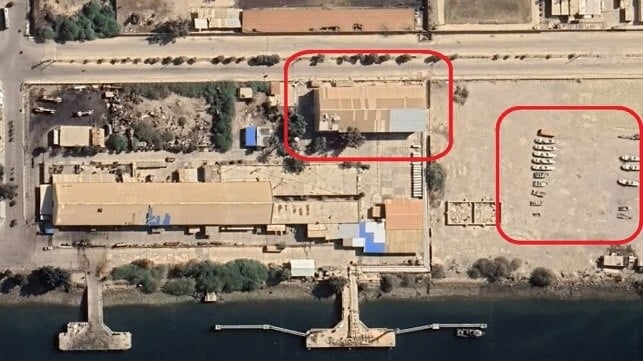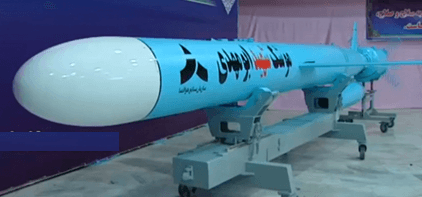Iran's Naval Forces Suffered Casualties From Israeli Airstrikes

Iranian naval forces did not escape unscathed in the recent 12-day Israeli aerial assault on Iran which began on June 12.
In the first two days of the Israeli attack, regular Iranian Navy (Nedaja) vessels largely remained in port. As naval vessels are at their most vulnerable when tied up in port, this move suggested that the Nedaja command was putting on a non-confrontational display that assumed that Israeli targeting priorities would be elsewhere.
But on June 14, Nedaja vessels left the Bandar Abbas Naval Harbor - which is home base to most of the principal ships of the Nedaja Southern Fleet - in somewhat of a hurry, taking up dispersal positions largely in the sea area between Bandar Abbas and the islands of Qeshm and Hormuz. As of June 28, a single Hengam Class landing ship had returned to port, but the rest of the Nedaja fleet has not yet come home.
Seen now from evidence on the ground, the targeting focus of the Israeli attacks was evidently air defense assets, nuclear weapons-associated research, production and scientists, key IRGC leaders and the IRGC Aerospace Force network of ballistic missile and drone launching, storage and production sites. The bulk of this target deck fell under the organizational structure of the Islamic Revolutionary Guard Corps (IRGC). Hence the Nedaja’s initial assumption that they would not be a targeting priority turned out to be largely correct.
However, the regular Armed Forces (Artesh) were not exempt. The Artesh Chief of Staff Major General Mohammad Bagheri, assassinated on June 13, was probably targeted because - besides being a hardline ideologue - he was assessed to be significantly more competent than anyone likely to succeed him.
Elements of the air defense network which were manned by the regular Iran Air Defense Force - which suffered 35 fatalities during the 12-day war - and airbases with air defense fighters at Mehrabad (1TAB), Tabriz (2TAB), Hamadan (3TAB), Isfahan (8TAB) and Mashhad (14TAB) were attacked. Additionally, it has emerged that the Nedaja was targeted on a number of other occasions.
On June 21, buildings of the Nedaja’s 1st Naval District at Bandar Abbas were attacked, and three conscripts killed; this suggests either that a headquarters building was struck which was not manned at the time, or that a storage depot was hit; in either case, the conscripts who died were likely to have been guarding the facility. Social media reports suggested that the targets attacked were armories containing unmanned aerial vehicles and munitions. By this time, ships of the 1st Naval District had already long since left the nearby Bandar Abbas Naval Harbor.
The Israelis would have had a focused interest in attacking those elements of Nedaja capability which posed a particular threat to Israel; this target list is likely to have included stocks of Qadr-380 and Abu Mahdi anti-ship missiles, which can be launched either from ships or coastal defense batteries and have a 650-mile range. The Israelis would also have wanted to destroy long-range drones that the Nedaja has often demonstrated it can fire from its warships.

Abu Mahdi anti-ship missile (IRIB)
The IRGC Navy (Nedsa) suffered rather more attention. Also on June 21, the base of the Nedsa’s 5th (Imam Mohammad Bagher) Naval District at Bandar Lengeh was attacked, which could be one of the suspected locations of an IRGC coastal cavern housing missile boats; an unlocated cavern has featured frequently in Nedsa propaganda videos released in recent months. At the same time, imagery posted by an open-source blogger showed a warehouse had been damaged in the Nedsa area of the Bandar Abbas Naval Harbor, which the IDF described as having stored drones (top).
What the Israelis described as an IRGC intelligence-gathering ship was also struck in the same area of the dock. Some external open source observers suggested that the vessel attacked was the Nedaja intelligence collection frigate IRINS Zagros (H313), but the target description better fits either the Nesda’s MV Saviz or Behshad, or a sister ship; up-to-date imagery of the areas where these ships normally berth, in the Shahid Bahonar area in the north-west of the Bandar Abbas naval basin, does not provide easy identification of the target vessel.
As yet, a threat to shipping traffic in the Straits of Hormuz has not emerged. But ships of both the Nedsa and the Nedaja are still at sea, likely to be putting on a display of strength in the Straits area in an attempt to suggest that they are still a force to be reckoned with.
